Artturi Ilmari Virtanen | |
|---|---|
 Virtanen in 1945 | |
| Born | Artturi Ilmari Virtanen 15 January 1895 |
| Died | 11 November 1973 (aged 78) Helsinki, Finland |
| Resting place | Hietaniemi Cemetery, Helsinki |
| Nationality | Finnish |
| Alma mater | University of Helsinki |
| Known for | AIV fodder |
| Spouse |
Lilja Moisio
(m. 1920; died 1972) |
| Children | 2 |
| Awards | Nobel Prize in Chemistry (1945) |
| Scientific career | |
| Fields | Chemistry |
| Institutions | |
Artturi Ilmari Virtanen (Finnish: [ˈɑrtːuri ˈʔilmɑri ˈʋirtɑnen] ⓘ; 15 January 1895 – 11 November 1973) was a Finnish chemist and recipient of the 1945 Nobel Prize in Chemistry "for his research and inventions in agricultural and nutrition chemistry, especially for his fodder preservation method".[1]
He invented AIV silage which improved milk production and a method of preserving butter, the AIV salt, which led to increased Finnish butter exports.[2]
Personal life
Artturi Ilmari Virtanen was born on 15 January, 1895, in Helsinki, Finland . He is the son of Kaarlo Virtanen, a railway engine driver and Serafina Isotalo.[3]
He completed his school education at the Classical Lyceum in Viipuri, Finland. He married the botanist Lilja Moisio (1894-1972) in 1920 and had two sons with her.[4]
In 1933, he bought a farm near Helsinki where he tested some of his scientific results in practice.[2] He saw in the overproduction of food only a temporary phenomenon. He lived a simple life, he never had a car of his own, never smoked and never consumed alcohol. He died of pneumonia in November 1973, following a broken femur from a fall few weeks prior. He was buried at the Hietaniemi Cemetery.[5]
Academics
Virtanen began his studies at the University of Helsinki in chemistry 1913 earning his Master and in 1918 his PhD in organic chemistry. In 1919 he started to work in the laboratories of Valio, a large producer of dairy products and became director of the laboratory in 1920. Feeling not fully qualified and following his interest in botany and zoology led him to further scientific education and so he left Valio and studied at the ETH, the University of Münster and the University of Stockholm he studied physical chemistry, soil chemistry and microbiology. In 1923 in Sweden he worked with Hans von Euler-Chelpin, who was awarded with the Nobel Prize in Chemistry in 1929. Back in Finland he became lecturer at the University of Helsinki in 1924, known for his lectures on chemistry of life. He worked in the laboratory of the Butter Export Association, which became a laboratory of the university. In 1930 the Institute for Biochemistry was founded and Virtanen stayed there until his death in 1973. He became professor of biochemistry at the Helsinki University of Technology in 1931 and at the University of Helsinki in 1939.[2]
Career
His research started with work on the phosphorylation of hexoses in 1924. He was able to show that phosphorylation is the first step in many fermentation reactions, which was the foundation of the Embden–Meyerhof pathway.
In 1925 his interests shifted to the nitrogen-fixing bacteria in the root nodules of leguminous plants. The improved methods of butter preservation, by adding disodium phosphate to prevent acidic hydrolysis. This method was in use for several decades in Finland. His research from 1925 till 1932 included the invention of a fodder preservation method (AIV fodder). The method, patented in 1932, was basically a kind of silage that improved the storage of green fodder, which is important during long winters. The process includes adding dilute hydrochloric or sulfuric acid to newly stored grain. Increased acidity stops harmful fermentation and has no adverse effect on the nutritive value of the fodder or the animals it is fed to. In 1945, Virtanen received the Nobel Prize in chemistry "for his research and inventions in agricultural and nutrition chemistry".[4]
His later years studies included the development of partially synthetic cattle feeds. The nitrogen for the synthesis of amino acids normally comes from proteins in the fodder. A special bacterial environment in the rumen of cattle allows them to use urea and ammonium salts as source for the nitrogen instead of plant proteins like soybean or meat and bone meal. He also headed the Valio Laboratory from 1921 to 1969.
Awards and honours
The prestige conferred by the Nobel Prize brought Virtanen invitations, honorary doctorates and membership in foreign academies of science.[2] He was a member of the Finnish, Norwegian, Swedish, Flemish, Bavarian, and Pontifical Academies of Science, and of the Swedish and Danish Academies of Engineering Sciences. He was an honorary member of learned societies in Finland, Sweden, Austria, Edinburgh, and the US, and received honorary degrees of the Universities of Lund, Paris, Giessen, and Helsinki, the Royal Technical College at Stockholm, and the Finland Institute of Technology.[4]
The asteroid 1449 Virtanen, discovered by the renowned Finnish astronomer and physicist Yrjö Väisälä, was named after him.[6] The lunar crater Virtanen is also named after him.[7]
Gallery
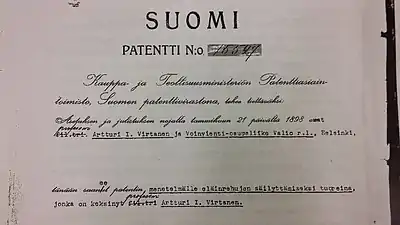 Part of the patent letter given to A. I. Virtanen and his employer for the AIV silage method in 1931
Part of the patent letter given to A. I. Virtanen and his employer for the AIV silage method in 1931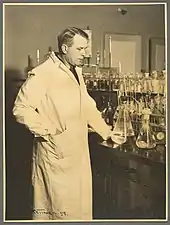 Virtanen at his laboratory in 1934
Virtanen at his laboratory in 1934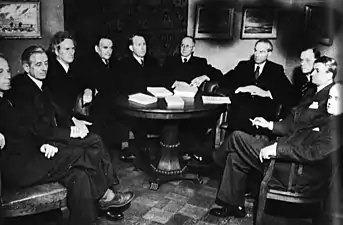 First members of Academy of Finland in April 1948, Virtanen to the left of glasses-wearing Onni Okkonen
First members of Academy of Finland in April 1948, Virtanen to the left of glasses-wearing Onni Okkonen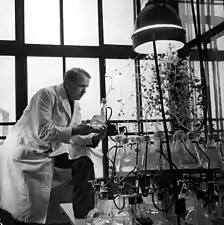 At his laboratory in 1949
At his laboratory in 1949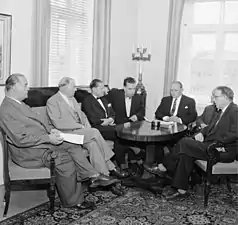 The Finnish Council of Nuclear Power presenting its estimation of costs at the Department of Finance in 1958, Virtanen on the right
The Finnish Council of Nuclear Power presenting its estimation of costs at the Department of Finance in 1958, Virtanen on the right![Photograph of a delegation (including L. A. Puntila [fi]) visiting professor A. I. Virtanen on his 70th birthday in 1965](../I/A-I-Virtanen-1965.jpg.webp) Photograph of a delegation (including L. A. Puntila) visiting professor A. I. Virtanen on his 70th birthday in 1965
Photograph of a delegation (including L. A. Puntila) visiting professor A. I. Virtanen on his 70th birthday in 1965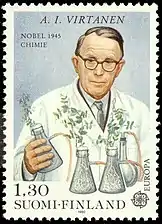 Postage stamp from 1980
Postage stamp from 1980
References
- ↑ "The Nobel Prize in Chemistry 1945." Nobelprize.org. Nobel Media AB 2014. Web. 15 June 2017.
- 1 2 3 4 Ihamuotila, Risto. "Virtanen, Artturi Ilmari (1895–1973)". The National Biography of Finland. Suomalaisen Kirjallisuuden Seura. Retrieved 31 January 2016.
- ↑ Biographical Index of Former Fellows of the Royal Society of Edinburgh 1783–2002 (PDF). The Royal Society of Edinburgh. July 2006. ISBN 0-902-198-84-X. Archived from the original (PDF) on 4 March 2016. Retrieved 17 February 2019.
- 1 2 3 "The Nobel Prize in Chemistry 1945". Nobelprize.org. Nobel Media AB. Retrieved 24 November 2015.
- ↑ "Hietaniemen hautausmaa – merkittäviä vainajia" (PDF). Helsingin seurakuntayhtymä. Retrieved 30 November 2017.
- ↑ Schmadel, Lutz D. (2003). Dictionary of Minor Planet Names – (1449) Virtanen. Springer Berlin Heidelberg. p. 116. ISBN 978-3-540-29925-7. Retrieved 1 November 2015.
- ↑ "Planetary Names: Crater, craters: Virtanen on Moon". planetarynames.wr.usgs.gov. NASA. Retrieved 14 October 2016.
- Brock, W. H. (2001). "Virtanen, Artturi Ilmari". Encyclopedia of Life Sciences. doi:10.1038/npg.els.0002936. ISBN 0470016175.
- Miettinen, Jorma K. (1975). "Artturi Ilmari Virtanen". Plant and Soil. 43 (1–3): 229–234. doi:10.1007/BF01928489. S2CID 11625579.
- R. A. Kyle; M. A. Shampo (1981). "Artturi Ilmari Virtanen". Journal of the American Medical Association. 246 (2): 150. doi:10.1001/jama.246.2.150. PMID 7017179.
- Kreula, Matti (1974). "In memoriam Artturi I. Virtanen 1895–1973". Zeitschrift für Ernährungswissenschaft. 13 (1–2): 1–5. doi:10.1007/BF02025018. PMID 4615448. S2CID 37234331.
External links
- Artturi Ilmari Virtanen on Nobelprize.org including the Nobel Lecture on 12 December 1945 The Biological Fixation of Nitrogen and the Preservation of Fodder in Agriculture, and Their Importance to Human Nutrition
